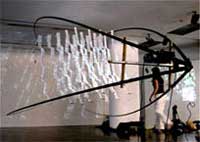Aether Induction House
General Description
Have computers and software been promoted to the role of “assistants”, tools that have important effects on the design? Or what are the perspectives and limitations of such servo mechanisms? Autonomous architecture? Building printers? Widespread solutions offered by software guides and wizards? The disappearance of the architect, or its role shifting to the design of algorithms that are able to figure out creative solutions without human intervention?
Here we are
presenting three constructed architectural prototypes discussing the above
questions; built metaphorical structures that bring together these design
aspects. Hybrid constructions, architectural models, engineered structures,
electronics and media design, all combined to create the experiments.
Our model of work is borrowed from
complexity science - systems thinking. Several modules of concepts and
constructions are produced, informing each other back and forth, developing
as a whole system with no pre-set hierarchy. The conceptual structure
develops and changes in relation of the building process. On the threshold
of architecture, media design, engineering we try to talk about a new
and different relationship between technology and design. The role and
effect of technology reveals a more profound relation between design and
design tools, and to quote Vilém Flusser here: we try to "turn
the automatic apparatus against automation".
To find these new qualities we rely on
experiments and testing on a 1 to 1 scale. Even if building installations
has physical limits in scale, the hybrid experience becomes real.
The physical structures have mathematical and computational inner logics,
results of algorithmic processes based on our decisions; they are generated
and processed forms. They have to function as physical structures as well
as projected structures.
The projections become volumetric, the physical structures are dissolved
in the flux of interactive media, and media become actual and spatial.
New qualities emerge that do not come from the physical structure or from
the media, these qualities are result of a symbiosis. The interaction
we create is symbolic, it is not really trying to function or process
information, but to transform the physical entity in a non physical way.
W hile contemporary interaction design usually takes on a very generic
form, object, and invents a very unique interaction, we go from the other
end; we create structures and materiality that are unique with their hybrid
logic of being a media space as well as an architectural structure, but
in our case the interaction model is more generic.
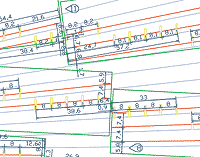
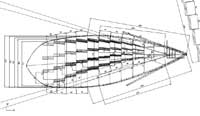
Version
one
The Fish tank
The geometric principles of the prototypes come from the development of the same idea: deconstructing a flat screen in three dimensions within the projection cone. Fragments of the screen displaced into the depth of projected light have to follow the rule of shadows, once a ray of light is picked up, other objects can't be placed on the same ray. This is the main criteria for engineering the space, but depending on the initial decisions this can result in diverse deconstruction setups. The first deconstruction models became the base of the latter prototype geometries.
The first prototype was 100X100X60 cm in size, built from a metal structure and textile strips. The interaction electronics and interfaces were all built by ourselves, and d ue to our limitations in programming and hardware skills, we used Macromedia Flash as a projection engine. To interface this program to sensors, we used a computer mouse, and a small device that was clicking Morse code messages on the Mouse button, where flash was listening to those. A human protocol on a human interface. Low tech and DIY (Do It Yourself). It started out as a necessity than became a choice for our technologies. Through constant re-appropriation of existing technologies we create new interfaces that hold connotations towards their original use, so stay familiar, but are placed into a new context.
The first prototype was built as a foldout version of the computer screen, transforming digital content into spatial experience. As a result we discovered a new materiality that turned a physical entity into a spatial media field in a surreal and surprising way. On the surface little interactive insects were sliding around as on water, reacting to the electromagnetic waves of the mobile phones and the movement of the visitors.
The fish tank was built in Barcelona in the metal workshop of Diego Herrero, in Budapest and was exhibited at the Közben exhibition that has featured the last 10 years of the Hungarian architecture at Mucsarnok (Kunsthalle Budapest) in October 2003.


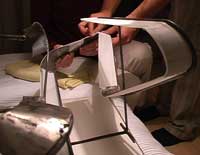
Distributed Projection Structure
Departing from the experiences of the first built prototype we designed a second, larger and more complex low budget installation. We wanted to try a simpler geometry to demonstrate the spatial rules in a cleaner and more abstract way; also with a more complex interaction and a more abstract ambient media design concentrated on the materiality. This time we split up the projection surface to 300 physical pixels and distributed them in 3d by an algorithmic order. The 5X5X0.8 cm transparent plastic elements, polished on one side created a dense volumetric structure. The pixels were supported by 3mm stainless steel bars that were fixed in perforated steel sheets on the ground. This projection structure embedded the media in a surprising way: the colour layers moving in space created a projected volume changing smoothly influenced by the interaction through the visitors' movements measured by ultrasonic sensors. The interaction and media designs were made in Macromedia Flash with the intention to align the projection with different parts of the built structure. This way we could have tests beyond the physical transformation of the projected media: reaching precision on a built structure in relation to the resolution of media.
This second prototype was built
in Barcelona with the kind help of Fabian Asunción and was tested
in Stockholm in the Smart Studio and exhibited on the Pixelache audiovisual
architecture festival in Helsinki at the Kiasma Centre for Contemporary
Art in April 2004.
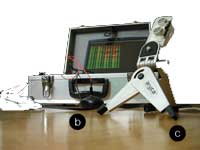

Version Three
The Fishing Kit
The third prototype has participated between the 11th and 23rd of August at the International Symposium on Electronic Art ISEA2004 in Helsinki and was exhibited at Gallery U at the Hungarian Cultural Institute.
This construction was the largest of the three: The 300X300X600 cm self-tensioned structure was made out of fishing rods, plastic strings, led weights, lambing gums and metal rings. For the projection bands we used double-folded cash register paper rolls that were hanging in the necessary parabolic shapes for the exact projection. The bands are positioned and sustained by the weights (approximately 1kg) and strings. The media here was designed by Bengt Sjölén, independent gaming technology researcher, using OpenGL, computer vision and Linux. The media was connected through small cameras to its environment for fast and responsive interaction, the 3d texture changes in relation to the built 3 dimensional structure.
